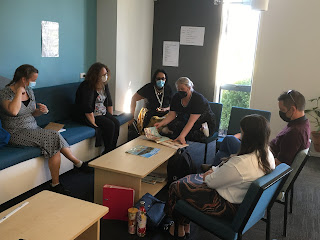This whole poetry thing has had me thinking about something that I find hugely interesting: leading for creativity. How do we 'lead for creativity'? What works? A HUGE question, and not one to be answered in a brief blog post, but it's had me reflecting on our Te Huruhuru Ao o Horomaka Hornby High School experience, and what I think I might have learned.
Warning: this post contains plenty of 'reckons', plenty of speculation and opinion based solely upon personal experience and observation.
At the start of most years, in the good old fashioned 'Principal's state of the nation address' to staff, I always talk about creativity. Each year I reveal a little more of myself. I ask staff what creativity looks like for them personally, and how it might reflect in their practice for the coming year. I'm a bit of a 'broken record' in that regard.
Late last year I discovered my own 'poetic voice' (despite not doing too well in the poetry section of a creative writing paper at Massey Uni a few years ago), inspired by the possibly less than reputable American poet Charles Bukowski. I discovered free verse poetry, and find it liberating. In the past 6 months I have written over 80 pieces ... they just 'come to me' at odd times, inspired by strong emotion. Finding a tear in your eye as you watch a small child covered in wounds lying in a hospital bed in the Ukraine does interesting things to the brain, I find.
I have taken to posting the occasional poem for staff, and have thought about why I'm doing that. Is it ego? Is it a 'look at me' thing? I hope not; it's much more important than any of that.
When we re-imagined out vision as 'he puna auaha a centre of creative excellence', we supported that with a strategic intent to support greater risk taking amongst our students. Our student Board rep at the time was strong in his advocacy in this regard, telling us loud and clear that HHS students were often unwilling to take risks. If we are to ask our students to take risks, we have to model that behaviour ourselves, and my own acts of posting poetry are just that. It is incredibly nerve wracking to post your work in front of your peers. You lay your soul bare before them, open to criticism. I want my colleagues to be prepared to do the same.
As a leader, for me it is a matter of 'If I'm going to ask you to do that, then I have to be prepared to do it myself, so here it is, this is what it looks like'. I am NOT expecting my colleagues to become poets. I am hopeful that they will model risk taking and creativity for our rangatahi, supporting and encouraging them to do the same.
There is a deeper issue here. How do you grow a creative organisation if the leader(s) do not believe it is important? Duh.., simple!! You don't!!!! A possibly related question is 'does leader creativity matter'?
To me, the first question is anathema. I led our re-imaging because I believe that creativity is central to our humanity, central to what will continue to separate us out from artificial intelligence, central to our capacity to be truly human, to be fulfilled, and I am completely convinced by and committed to the belief that creativity supports well-being and achievement.
At the risk of doing their significant body of work a disservice, I would like to quote from 'Replanting creativity during post normal times' (October 2920) ©Professor Peter O’Connor Director, Centre for Arts and Social Transformation Professor Michael Anderson, Associate Professors Kelly Freebody and Paul Ginns, The University of Sydney October 2020:
Beyond increasing recognition of the role of creativity in a successful, globalised citizenry, there are many direct and indirect benefits of developing creative skills in and with students. Upitis (2014) discusses how
"Fostering creativity in students helps them to develop resilience, resourcefulness, and confidence—preparing them to address life’s challenges. Creativity also carries its own intrinsic value. Developing creative sensibilities and habits enhances quality of life for teachers and students." (p. 2).
The team also documents the economic gains to be had from enhanced creativity across the population, but that is a story for another day.
I reckon that if we are to enhance creativity in schools, we need to put into positions of leadership those who understand the importance of creativity, those who are committed to its value and its development. We need less ego and more moral purpose, less focus on testing and more focus on inspiration.
I had originally wondered if leader creativity is important. Not sure, it may or may not be, but certainly an unwavering commitment to creativity and its intrinsic and extrinsic value to our rangatahi and our society are essential, I reckon.
I would like to link this back to our Manaiakalani kaupapa. Our kaupapa bases all that we do around the pedagogy 'Learn Create Share'. Creativity sits in the middle, essential to liberating our learners, to harnessing their talent, to growing their self belief, and to driving up achievement. It does just that, Nationally we know that we accelerate writing progress by twice national averages.
The pedagogy unites kura and teachers in a coherent consistent evidence based practice that works. Surely you couldn't ask for more than that?

